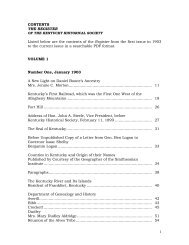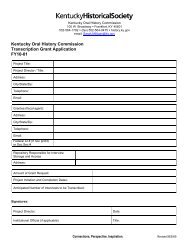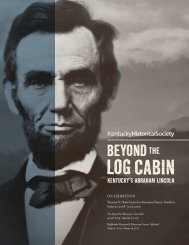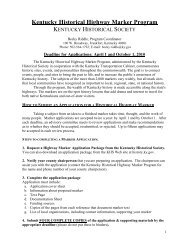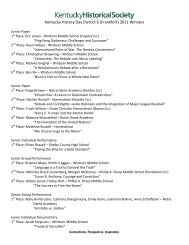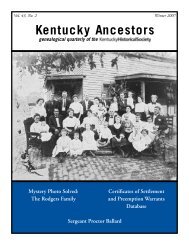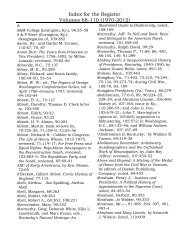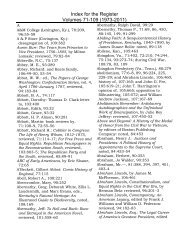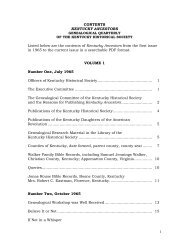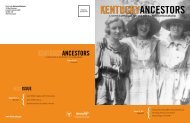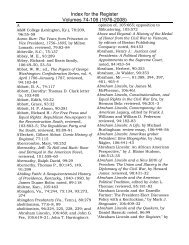Kentucky Ancestors, Volume 46, Number 2 - Kentucky Historical ...
Kentucky Ancestors, Volume 46, Number 2 - Kentucky Historical ...
Kentucky Ancestors, Volume 46, Number 2 - Kentucky Historical ...
Create successful ePaper yourself
Turn your PDF publications into a flip-book with our unique Google optimized e-Paper software.
for specific projects such as building railroads and<br />
turnpikes, or improving the navigation of any river<br />
within the commonwealth.<br />
1867 (8 March)<br />
Taxpayers were ordered to report, under oath,<br />
the amount of annual income he or she derived<br />
from interest paid on bonds issued by the United<br />
States government. This included bonds owned by<br />
the taxpayer, or held in trust for another, or in any<br />
fiduciary capacity. The sums were to be listed in a<br />
separate column on the tax form labeled “Income<br />
from United States Bonds.” The tax assessment was<br />
5 percent on the gross amount of such income; the<br />
amount was to be collected by the sheriff or other<br />
collecting officer of revenue when other taxes were<br />
received. The tax on U.S. Bonds was to be “set apart<br />
and placed on deposit in any bank on terms as to<br />
interest, to be held subject to the future action of<br />
the Legislature.” The act was in force from its date of<br />
passage. 12 Legislation dated March 1871, amended<br />
the act entitled “An Act to tax income on United<br />
States Bonds’ approved March 8, 1867” by requiring<br />
all money collected under the provisions of the<br />
former act be paid into the treasury to the credit of<br />
the “revenue proper.” The Auditor of Public Accounts<br />
was directed to transfer such money that may be<br />
on hand immediately. 13 Note: The Bonds Act was<br />
challenged by the Bank of <strong>Kentucky</strong> and declared<br />
illegal and unconstitutional by the <strong>Kentucky</strong> Court<br />
of Appeals. In 1873 the <strong>Kentucky</strong> General Assembly<br />
ordered a refund of all taxes assessed and collected on<br />
income derived from United States bonds. The 1873<br />
act further repealed the Act of March 8, 1867. 14<br />
1867 (8 March)<br />
An Act to provide for the Assessment for taxation<br />
of the property of corporations and the more speedy<br />
collection of back taxes due thereon.<br />
The <strong>Kentucky</strong> General Assembly ordered county<br />
courts to initiate tax assessment on all property or<br />
estate of any corporation that had not been listed or<br />
assessed in any year since 10 January 1856. “And any<br />
assessment thus made shall be certified to the proper<br />
collecting officer who shall collect the amount so<br />
certified as due from said corporation to the State on<br />
account of back taxes, in the same manner that public<br />
revenue is now collected.” The attorney general was<br />
authorized to represent the state in all proceedings<br />
80 | <strong>Kentucky</strong> <strong>Ancestors</strong><br />
against corporations to recover back taxes. The act<br />
was in force from its date of passage. 15 Note: Tax lists<br />
may report the corporation as “Jacob Cozatt & Co., 1<br />
Mill, valued at $2000.”<br />
1867 (11 March)<br />
Sheriffs and other collecting officers of the<br />
commonwealth were authorized to receive in<br />
payment of taxes and other public dues “the currency<br />
known as United States legal tender notes, and the<br />
notes of the various National Banks, established by<br />
the authority of the United States: Provided, That<br />
the notes of said banks when received are current and<br />
at par with legal tender notes; and it shall be the duty<br />
of the Treasurer to receive into the Public Treasury<br />
said currency, and pay the same out in discharge of<br />
all claims upon the Commonwealth.” The act was in<br />
force from its date of passage. 16<br />
Tax assessors were directed to report, in full, the<br />
first name of all taxpayers. The act was retroactive to<br />
1 January 1868. 17<br />
1868 (13 February)<br />
An Act to amend an Act approved March 2,<br />
1865, entitled “An Act allowing School Districts to<br />
levy a District School Tax.<br />
The General Assembly amended previous<br />
legislation to allow Common School District No. 25,<br />
in Grant County, to levy and collect a tax of no more<br />
than $.25 per year per $100 of taxable property in<br />
said district, for the purpose of paying for a school<br />
house. The act was in force from its passage. 18 Note:<br />
On 16 January 1869, the Act of March 2, 1865,<br />
was further amended to allow Common School<br />
District No. 15 (Cherry Grove) in Bracken County<br />
to levy and collect a similar tax of no more than<br />
$.25 per year per $100 of taxable property for school<br />
purposes. 19 On 25 February 1869, Common School<br />
District No. 15 in Grant County was permitted to<br />
levy and collect a tax of no more than $.20 in any one<br />
year per $100 of taxable property for the purpose of<br />
building a school house. 20<br />
1868 (21 February)<br />
As no revenue tax due the state from Floyd<br />
County for the year 1860 had been paid into the<br />
treasury, “in consequence of there having been no<br />
sheriff in said county for that year,” the General<br />
Assembly authorized the auditor of public accounts





